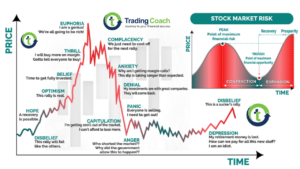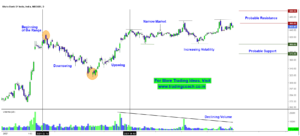In this article, I will cover about Price action bars. Two important types of Price action bars, their market structures and how they are used in my practical trading.
Candlestick patterns are categorized into multiple structures. The problem with trading candlestick patterns becomes obvious, after some experience in live markets. Hypothetical branching of candlestick patterns, are not necessary for successful trading. As a Price action trader, my principle is to keep things simple and consistent. My focus is on buying and selling pressure, which is visible in market structure. Trade Management and discipline are my secondary core elements.
New to Price action trading? Learn about market structure and Price action
REPLACE THE TERM CANDLESTICK PATTERNS WITH PRICE ACTION BARS
When I trade price action, my approach to candlestick is efficient and practical. Instead of looking at fancy names, such as pin bars, doji, engulfing bars etc. I broadly classify them into two types of patterns, based on their lower time frame price action. I call them as Trending price action bars and Ranging Price action bars. Obviously, Price action bars are classified on the basis of primary market movements, Trends and Ranges.
Large and medium-sized candlesticks contain trends on lower time frames, especially if the close and open are near opposite ends. I call these candlesticks as Trending Price action bars. Candlestick patterns such as Marbozu, Bearish engulfing, bullish engulfing all are categorized as trending bars in my dictionary. Small sized candlesticks are probably ranges on lower time frames, and candlesticks have their opens and closes near to the each other. Larger the shadows, more volatile the ranges are. I categorize these candlesticks as Ranging Price action bars. Candlestick patterns like doji’s, Pin bars, Spinning tops etc. falls into this category.
This is a simple concept, It’s the key to build intuition about price action and multi time frames. Categorizing candlesticks in this manner, helps to avoid over analysis and simplifies the analytical process. It encourages us to read price action, on a bar by bar basis. Every candlestick is either Trending bar or Ranging Bar. If it has a small-sized body, we conclude- it has a LTF ranging structure. Vice versa, if it has a large body, we conclude – it has a LTF Trending structure. What is the purpose of classifying candlesticks, in such a manner? what does ranging price action bars and trending price action bars, have to do with practical trading? Learn about lower time frame scenarios and candlestick patterns here
USEFULNESS OF TRENDING AND RANGING PRICE ACTION BARS
When we approach candlesticks in the context of price action bars, it reveals more information about market dynamics and structure. Traditional approaches of candlestick patterns, restricts us from information about market psychology. But, by using the concept of price action bars, market reveals the structure of its behavior and psychology. In laymen terms, Price action bars helps us to think deeply about, what’s going on behind the scenes. Remember Price action bar is not a standalone topic; they’re considered in relationship with market structure and other concepts.
In chart A – Price is testing the highs, when price action spikes to new extremes, it’s unable to find buying pressure to support further moment. If we put this in terms of price action bars, it reveals some structural information. After a series of trending bars, Price action tested the highs, which resulted in a couple of ranging bars. In addition, bars are becoming smaller, indicating that buying pressure is exhausted. The small bars, which we can see in chart A is nothing but trading ranges in lower time frame. Note the Chart B – the lower time frame picture of price action, clearly shows the change in buyer’s conviction around resistance. Couple of ranging bars at resistance is a sign of correction or even a slight reversal.
Interested in learning Price action trading and institutional trading strategies? check out my premium course.
Such a precise market story and clarity can’t be seen, by using fancy names for candlesticks. It further restricts us from understanding buying and selling pressure. But when we use the concept of price action bars, it elaborates and gives more information about the market’s reality. Looking at candlesticks in this way will improve one’s consistency and trading results. There are multiple ways you can use the concept of price action bars, in your trading strategy. If you have any doubts, queries or feedback’s, please post it on the comments below.






